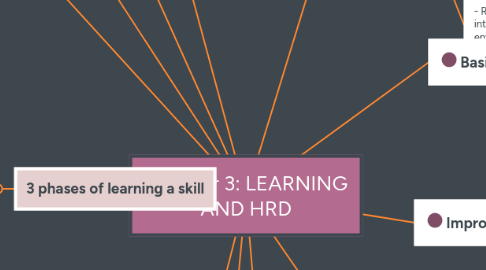
1. Perceptual preference
1.1. - Print
1.2. - Visual
1.3. - Aural
1.4. - Interactive
1.5. - Tactile/manipulative
1.6. - Kinesthetic/psychomotor
1.7. - Olfactory
2. 5 learning strategies
2.1. - Rehearsal strategies
2.2. - Elaboration strategies
2.3. - Organizational strategies
2.4. - Comprehension monitoring strategies
2.5. - Affective strategies
3. Kolb’s learning styles
3.1. - Convergent
3.2. - Divergent
3.3. - Assimilation
3.4. - Accommodative
4. How to assess trainee differences
4.1. Instrumentality : Does trainee think training is applicable?
4.2. Skepticism : Degree trainee questions and demands facts
4.3. Resistance to change : How well is change accepted?
4.4. Attention span : How long can trainee focus on the lesson?
4.5. Expectation level : What does trainee expect from the training?
4.6. Dominant needs : What motivates the trainee?
4.7. Absorption level : How fast is new information accepted?
4.8. Topical interest : How interested is trainee in topic?
4.9. Self-confidence: Degree of independence and self-regard
4.10. Locus of control : Can trainee implement training on job?
5. 3 phases of learning a skill
5.1. Declarative knowledge : forming a mental picture of the task
5.2. Knowledge compilation : integrating knowledge and motor skills
5.3. Procedural knowledge : ability to perform task automatically paying little attention to it
6. Maximizing transfer
6.1. - Identical elements
6.1.1. The closer the training is to the job, the easier it is to achieve transfer
6.1.2. Direct relationship to the job
6.1.3. Eg; Customer service and angry customers
6.2. - Physical fidelity
6.2.1. Same physically
6.2.2. Same procedurally
6.2.3. Eg; Flight and submarine simulator
6.3. - Psychological fidelity
6.3.1. Trainee experiences same stresses and conditions as he/she is being trained for
6.3.2. Eg; MS flight simulator
7. Other types of transfer
7.1. - Near transfer : Ability to directly apply back to the job
7.2. - Far transfer : Expanding upon or using in new and creative ways
8. Maximising learning (Training)
8.1. - Trainee characteristics
8.1.1. Train ability: Motivation, Ability, Perception of the work environment
8.1.2. Personality and attitudes
8.2. - Training design
8.2.1. Conditions of practice
8.2.1.1. - Active practise
8.2.1.2. - Spaced vs massed practice
8.2.1.3. - Whole vs part learning
8.2.1.4. - Over learning
8.2.1.5. - Knowledge of results
8.2.1.6. - Task sequencing
8.2.2. Retention of what is learned
8.2.2.1. - Meaningfulness of the material
8.2.2.2. - Degree of original learning
8.2.2.3. - Interference
8.3. - Transfer of training
8.3.1. Does training make it to the job?
8.3.2. Positive transfer : Job performance improves after training
8.3.3. Zero transfer : No measurable changes
8.3.4. Negative transfer : Performance becomes worse after training
9. Instructional psychology
9.1. - What must be done before learning can take place
9.2. - Describe the learning goal to be achieved
9.3. - Analyze the initial state of the learner
9.4. - Identify the conditions allowing the learner to gain competence
9.5. - Assess and monitor the learning process
10. Learning
10.1. - Focus is upon change
10.2. - Change must be long-lasting
10.3. - The focus of learning can be cognitive, behavioural or affective
10.4. - Results from the individual’s interaction with the learning environment
11. Basic learning principles
11.1. - Contiguity: things taught together become associated with each other
11.2. - Law of effect : a behaviour followed by pleasurable experience is likely to repeated
11.3. - Practice: repetition increases association and knowledge
12. Improved training design
12.1. - Task analysis
12.1.1. Break each task down into a series of distinct component tasks
12.1.2. Keep breaking tasks down to the simplest level possible
12.2. - Component task achievement
12.2.1. Each task must be completed fully before the entire task may be performed correctly
12.2.2. You have to specify what is to be done, under what conditions, and how it is to be evaluated
12.3. - Task sequencing
12.3.1. Each component task should be arranged in the proper sequence
12.3.2. Some are serial tasks while some can be done in parallel
